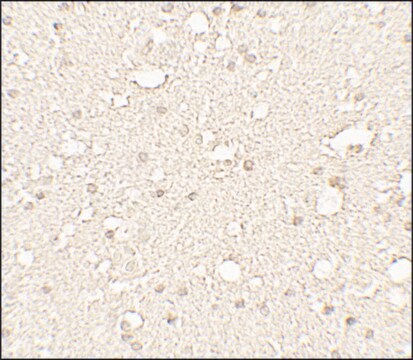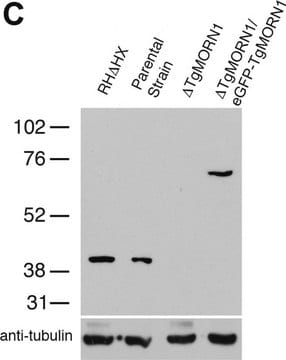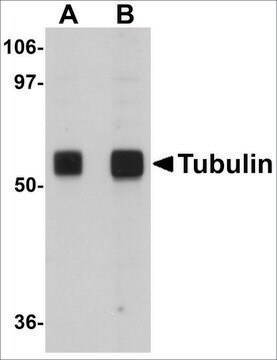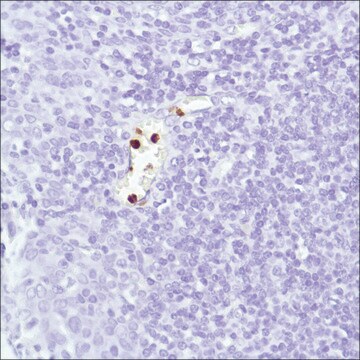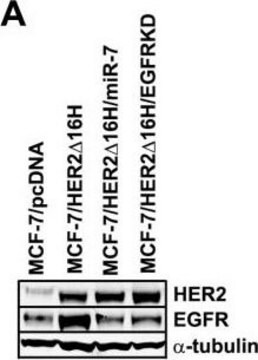CBL270-I
Anti-alpha-Tubulin Antibody, clone YOL1/34
clone YOL1/34, from rat
Synonyme(s) :
Tubulin alpha-1 chain, alpha-tubulin
About This Item
Produits recommandés
Source biologique
rat
Niveau de qualité
Forme d'anticorps
purified immunoglobulin
Type de produit anticorps
primary antibodies
Clone
YOL1/34, monoclonal
Espèces réactives
rat, mouse, human, yeast, amoeba, porcine
Technique(s)
ELISA: suitable
affinity binding assay: suitable
electron microscopy: suitable
immunocytochemistry: suitable
western blot: suitable
Isotype
IgG2aκ
Numéro d'accès NCBI
Numéro d'accès UniProt
Conditions d'expédition
ambient
Modification post-traductionnelle de la cible
unmodified
Informations sur le gène
Saccharomyces cerevisiae ... Tub1(854889)
human ... TUBA1A(7846)
Description générale
Spécificité
Immunogène
Application
Western Blotting Analysis: 1 µg/mL from a representative lot detected alpha-tubulin in 10 µg of NIH/3T3 mouse fibroblast and PC12 rat pheochromocytoma cell lysates.
Affinity Binding Assay: Pig brain α-tubulin, α-tubulin/β-tubulin heterodimer, as well as α-tubulin proteolytic fragments a.a. 414-425 and a.a. 403-422, but not β-tubulin or actin, effectively competed against immobilized α-tubulin for YOL 1/34 binding (Breitling, F., and Little, M. (1986). J. Biol. Chem. 189(2):367-370).
Electron Microscopy Analysis: A representative lot immunostained microtubules of crude yeast nuclear envelope preparation (Kilmartin, J.V., et al. (1982). J. Cell Biol. 93(3):576-582).
ELISA Analysis: A representative lot detected pig brain α-tubulin by direct (non-sandwich) ELISA (Breitling, F., and Little, M. (1986). J. Biol. Chem. 189(2):367-370).
Immunocytochemistry Analysis: A representative lot immunostained fixed NIH/3T3 cells as well as yeast spheroplasts and nuclei preparations (Kilmartin, J.V., et al. (1982). J. Cell Biol. 93(3):576-582).
Immunocytochemistry Analysis: A representative lot immunostained microtubules of fixed Dictyostelium (amoeba) as well as isolated and stabilized amoeba cytoskeleton (Kilmartin, J.V., et al. (1982). J. Cell Biol. 93(3):576-582).
Western Blotting Analysis: A representative lot detected α-tubulin in spermatozoa sample from from fertile and infertile men (Breitling, F., et al. (1991). Gene. 104(2):147-153).
Qualité
Western Blotting Analysis: 1 µg/mL of this antibody detected alpha-tubulin in 10 µg of HeLa cell lysate.
Description de la cible
Liaison
Forme physique
Autres remarques
Vous ne trouvez pas le bon produit ?
Essayez notre Outil de sélection de produits.
Code de la classe de stockage
12 - Non Combustible Liquids
Classe de danger pour l'eau (WGK)
WGK 1
Point d'éclair (°F)
Not applicable
Point d'éclair (°C)
Not applicable
Certificats d'analyse (COA)
Recherchez un Certificats d'analyse (COA) en saisissant le numéro de lot du produit. Les numéros de lot figurent sur l'étiquette du produit après les mots "Lot" ou "Batch".
Déjà en possession de ce produit ?
Retrouvez la documentation relative aux produits que vous avez récemment achetés dans la Bibliothèque de documents.
Notre équipe de scientifiques dispose d'une expérience dans tous les secteurs de la recherche, notamment en sciences de la vie, science des matériaux, synthèse chimique, chromatographie, analyse et dans de nombreux autres domaines..
Contacter notre Service technique